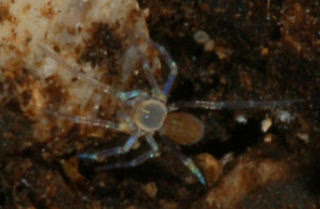
The Tooth Cave spider, formerly Neoleptoneta myopica, now Tayshaneta myopica, is a 1.6 mm long spider in the family Leptonetidae. It is endemic to limestone caves near Austin, Texas in the United States and is considered an endangered species.
Spelaeorchestia koloana, the Kauaʻi cave amphipod or ʻuku noho ana in Hawaiian, is a cave-dwelling crustacean only found on the Hawaiian island of Kauaʻi. It is eyeless and measures 7–10 mm (0.28–0.39 in) long. It is only known from 10 populations, and eats decaying plant matter and other decomposing material.
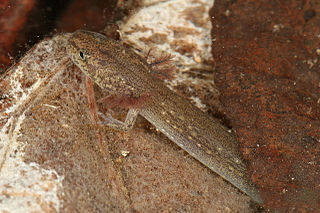
The Jollyville Plateau salamander is a species of salamander in the family Plethodontidae. It is also known as the Tonkawa Springs salamander. It is endemic to Travis and Williamson counties, Texas, United States. This species is perrenibranchiate, retaining its gills throughout life.
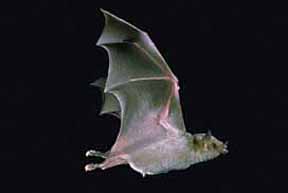
The greater long-nosed bat or Mexican long-nosed bat is a species of bat in the family Phyllostomidae. It is found in Mexico and the United States. It chiefly consumes pollen and nectar, particularly from agave plants and cacti. Its habitat includes desert scrub and open woodlands. It is threatened by habitat loss.
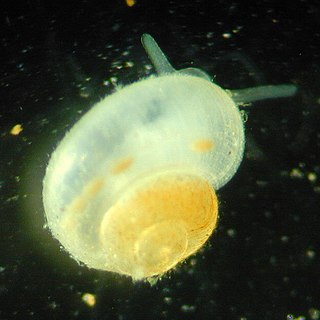
The Tumbling Creek cavesnail is a species of freshwater cave snail with gills and an operculum, an aquatic gastropod mollusk in the family Amnicolidae.
Assiminea pecos is a rare species of snail in the family Assimineidae known by the common name Pecos assiminea. It is native to New Mexico and Texas in the United States. Specimens known from Mexico are now treated as members of a separate species, Assiminea cienegensis. The Pecos assiminea was federally listed as an endangered species of the United States in 2005.
The phantom cave snail or phantom cavesnail is a species of very small freshwater snail with an operculum, an aquatic gastropod in the family Hydrobiidae.

Lampsilis bracteata, also known as the Texas fatmucket, is a species of freshwater mussel, an aquatic bivalve mollusk in the family Unionidae, the river mussels.
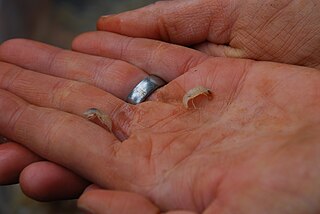
Antrolana lira is a species of crustacean in family Cirolanidae, the only species in the genus Antrolana. It is an unpigmented troglobite with no eyes, reaching a maximum length of 0.7 inches (18 mm).
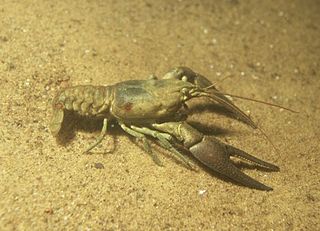
Cambarus aculabrum is a rare species of cave-dwelling crayfish known by the common name Benton county cave crayfish. It is native to Arkansas in the United States, where it is known from only four locations. It is a federally listed endangered species of the United States.
Gammarus hyalelloides is a species of amphipod crustacean in the family Gammaridae. It is endemic to four springs in Jeff Davis County and Reeves County, Texas, and is listed as a vulnerable species on the IUCN Red List.

Gammarus pecos, commonly known as the Pecos amphipod, is a species of crustacean in family Gammaridae. It is endemic to Pecos County, Texas in the United States, where it is known from only two locations: Diamond Y Spring and Leon Creek.
Palaemonetes antrorum, also known as the Balcones cave shrimp and the Texas cave shrimp, is a species of palaemonid shrimp endemic to Texas. It is listed as an endangered species on the IUCN Red List, and as a Species of Concern by the United States Endangered Species Act.
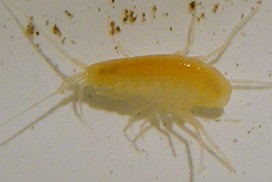
Stygobromus pecki is a rare species of crustacean known by the common name Peck's cave amphipod. It is endemic to Texas in the United States, where lives in only two springs in Comal County. It is a federally listed endangered species of the United States, and is listed as Endangered on the IUCN Red List.
Texella reddelli, the Bee Creek cave harvestman, is a rare species of troglobitic harvestman that was added to the United States endangered species list in 1988, at the same time as six other species native to the karst ecosystem in Travis County and Williamson County, Texas, USA. They inhabit areas with near 100% humidity and constant temperatures, and they prey on springtails. Since they can only be found underground, research on these creatures has been difficult. Their distribution is limited and unknown reproductive rates mean that it is possible they are especially susceptible to habitat destruction and other threats. Texella reddelli are found on both the North and South sides of the Colorado River.

The Kretschmarr Cave mold beetle is a small mold beetle.

Frankenia johnstonii is a species of flowering plant known by the common name Johnston's seaheath, or Johnston's frankenia. It is native to southern Texas in the United States and northern Nuevo León in Mexico, where there are about 30 occurrences known. The plant was federally listed as an endangered species in the United States in 1984. It was found to be more abundant than previously thought and it was proposed for delisting in 2003.
The Coffin Cave mold beetle, also known as the Inner Space Caverns mold beetle, is a small insect that is only found in caves. They are very small at 2.60–2.88 mm (0.102–0.113 in) and lack any form of eyes. They are found exclusively in caves in a single county in Texas, Williamson County. The United States Fish and Wildlife Service considers the Coffin Cave mold beetle to be an endangered species. Threats facing this species include urbanization.
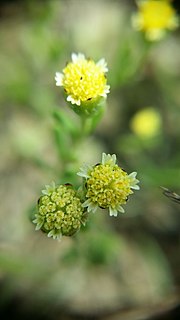
Hymenoxys texana is a rare species of flowering plant in the aster family known by the common names prairie dawn, Texas prairie dawn-flower, and Texas bitterweed. It is endemic to Texas, where it is known only from the general vicinity of Houston. It is threatened by the loss of its habitat. It is a federally listed endangered species of the United States.
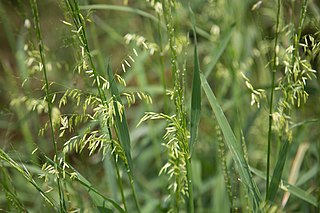
Zizania texana is a rare species of grass known by the common name Texas wild rice. It is endemic to Texas, where it is found only on the upper San Marcos River in Hays County. It is threatened by the loss and degradation of its habitat. It is a federally listed endangered species of the United States.














